The CBRN Protection Equipment Market is estimated to be valued at USD 6.7 billion in 2025 and is projected to reach USD 11.2 billion by 2035, registering a compound annual growth rate (CAGR) of 5.3% over the forecast period.
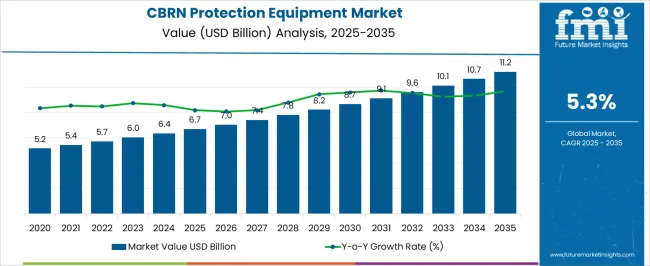
| Metric | Value |
|---|---|
| CBRN Protection Equipment Market Estimated Value in (2025 E) | USD 6.7 billion |
| CBRN Protection Equipment Market Forecast Value in (2035 F) | USD 11.2 billion |
| Forecast CAGR (2025 to 2035) | 5.3% |
The CBRN Protection Equipment market is experiencing steady growth due to increasing global focus on defense preparedness, counter-terrorism measures, and public safety infrastructure. Current market trends indicate that military, defense, and emergency response organizations are prioritizing modernized protection solutions capable of addressing chemical, biological, radiological, and nuclear threats. Growth is being driven by rising geopolitical tensions, investments in border security, and heightened awareness of hazardous material handling.
Technological advancements have enabled equipment to be more lightweight, portable, and adaptable, enhancing operational efficiency for both mobile and stationary deployments. Additionally, increasing regulatory requirements for safety compliance and emergency response preparedness across multiple nations have strengthened market demand.
With the adoption of modular systems, equipment that can be upgraded through software or accessory integration is becoming increasingly favored, thereby extending operational life cycles Looking forward, the market is expected to benefit from continuous innovations in filtration, detection, and decontamination technologies, ensuring that military and civil defense agencies have effective and scalable solutions to mitigate CBRN threats.

The Mobile / Transportation CBRN Protection Equipment segment is projected to hold 20.00% of the market revenue in 2025, making it a key category within the product type classification. Its leading position is being attributed to the flexibility and rapid deployment capabilities it offers in response to emergent CBRN threats. Mobile units can be integrated into vehicles or transportation platforms, providing protection to personnel during transit through hazardous zones, while supporting rapid on-site response.
The growth of this segment has been reinforced by the increasing emphasis on mobility and real-time threat mitigation in defense and emergency response strategies. Equipment in this category is favored because it combines operational efficiency with high protective performance, allowing military and civil teams to maintain readiness while minimizing exposure.
Adoption has been accelerated by modular designs that allow software-driven detection and filtering systems to be upgraded without hardware replacement As security agencies continue to prioritize agile deployment strategies and rapid response, this segment is expected to remain a leading contributor to overall market revenue.
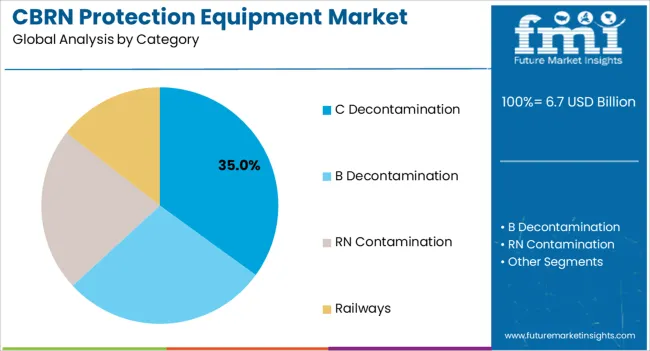
The C Decontamination category is expected to account for 35.00% of the overall market revenue in 2025, establishing it as a dominant functional segment. Growth in this category has been driven by the critical need to neutralize chemical and biological hazards safely and efficiently following exposure incidents. Decontamination equipment is being widely deployed across military installations, civil defense units, and emergency response teams to prevent the spread of hazardous materials and ensure personnel safety.
Increased adoption has been reinforced by advancements in portable decontamination technologies, including rapid deployment systems that can be used in both field and facility environments. Regulatory emphasis on contamination control and public safety has further accelerated market demand.
The ability to combine decontamination capabilities with modular protective systems enhances operational effectiveness, allowing personnel to perform essential mitigation tasks with minimal downtime As awareness of hazardous incidents rises and preparedness initiatives intensify, the C Decontamination category is expected to maintain its leading revenue share in the market.
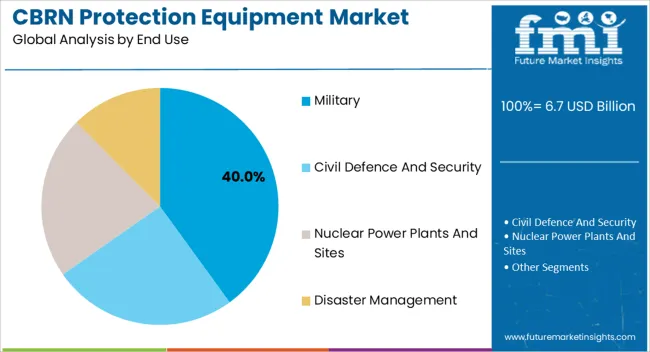
The Military end-use segment is anticipated to hold 40.00% of the CBRN Protection Equipment market revenue in 2025, highlighting its preeminent position in overall demand. This dominance is being driven by the need for advanced protective equipment capable of safeguarding armed forces against chemical, biological, radiological, and nuclear threats during combat and operational missions.
Adoption has been reinforced by the modernization of military forces worldwide, which emphasizes mobile, lightweight, and modular protective systems that can be upgraded and maintained efficiently. The focus on troop safety, mission readiness, and rapid deployment in unpredictable operational environments has further supported this segment’s growth.
Investments in training, simulation, and strategic defense programs have encouraged procurement of equipment that integrates detection, filtration, and decontamination capabilities As geopolitical uncertainties persist and military preparedness continues to be a priority, demand for comprehensive protective solutions within this end-use segment is expected to remain strong, ensuring continued revenue growth and sustained market leadership.
| Historical CAGR (2020 to 2025) | 4.7% |
|---|---|
| Forecasted CAGR (2025 to 2035) | 5.6% |
Sales of CBRN protection equipment increased at 4.7% CAGR between 2020 and 2025 with countries such as the United States, Mexico, China, India, and the United Kingdom accounting for a substantial portion of the global market.
Advanced training programs for the army and detecting and responding to incidents or accidents effectively will require securing CBRN materials. The demand for innovative CBRN materials is increasing by governments.
The demand for integrated collective protection equipment (COLPRO) in military camps is also increasing for military operations. This ongoing trend of CBRN protection equipment is forecast to enable growth in the global CBRN protection equipment market. The CBRN protection equipment market is projected to grow at a 5.6% CAGR during the forecast period of 2025 to 2035.
Use Of Chemical and Biological Weapons is Likely to Boost the Market Growth
Chemical weapons have been used often in recent years. For example, the recent use of chemical weapon attacks between 2012 and 2020 in Syria, where numerous people were killed. Such activities have increased the demand for CBRN protection equipment such as CBRN suits, masks, CBRN filtration systems, and others.
For instance, in February 2020, North Korean agents used a nerve agent (VX) in Kuala Lumpur Airport, Malaysia. To cope with this situation, manufacturers are offering modern protective equipment along with filtration system and advanced features that provide a higher degree of protection.
Biological warfare agents are extremely dangerous as small amounts of content are delivered by breathing or skin adsorption, which can cause extreme health issues and it is contagious. Numerous manufacturers are developing new CBRN protection equipment that is forecasted for the growth of the CBRN protection equipment market to secure common people from such biological agents.
High Cost of Equipment May Hamper the Market Growth
The high costs of equipment and services as well as the government’s relatively low expenditure on CBRN security for implementing top-notch security services. The expense of restraining numerous law enforcement and military organizations with vast amounts of capital, equipment, and labor is very high, which restrains the growth of the CBRN security market.
Emergency Medical Services (EMS) around the world have taken rigorous CBRN protection measures to prioritize patient safety. The management of possible chemical disasters brought on by either industrial accidents or terrorist activity falls under the purview of EMS.
The Hazardous Substances Management Division, which oversees the Ministry for the Management of Chemical Emergencies and Hazardous Substances in India, has implemented strict CBRN defense measures, which are projected to drive the market forward in the approaching years.
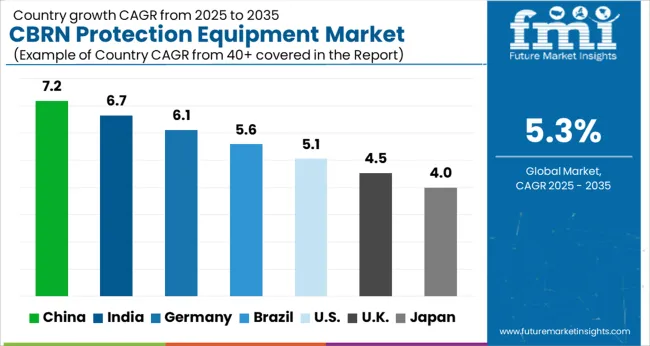
Increased Military Spending in China to Boost the Market Demand
As per FMI, China is projected to account for around 52.4% of the East Asia market by the end of 2035. China has become the world’s second-largest military spender, allocated $5.2 billion to the military in 2020, which accounted for 14 percent of global spending.
Military spending in China has increased substantially owing to the strengthening of armed forces. The sector’s spending in 2020 was almost 10 times higher than in 1994. China as an emerging country will offer prime opportunities for the growth of the CBRN protection equipment market in the incoming years. Hence, China is anticipated to grow with a remarkable CAGR of 5.5% during the forecast period 2025 to 2035.
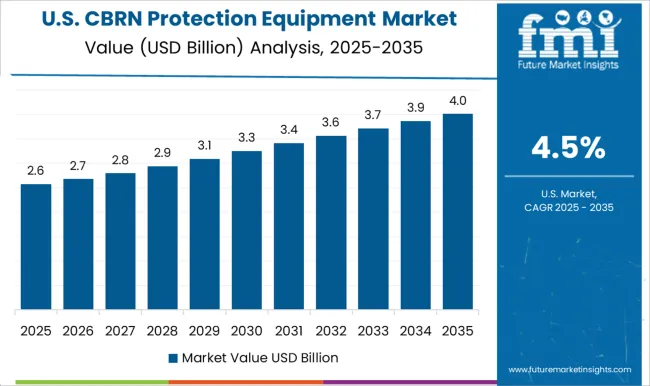
High Defence Spending to Drive the Market Growth in the United States
The United States currently dominates the world in terms of military expenditure. It accounted for 36 percent of the global military spending in 2020. The country spent almost as much on its military in 2020 as the next eight highest spenders combined. Military spending of the United States in year 2020 was 19% lower as compared to the year 2010.
The recent growth in global tensions between Iran and the United States has projected to propel the demand for CBRN Protection Equipment over the forthcoming years. The adoption of CBRN protection equipment will continue growing in the country due to rising geopolitical tensions. The United States is projected to account for approximately 87% of the North America CBRN protection equipment market at the end of 2035.

Increased Security Concerns to Drive the Market Demand
Germany is estimated to hold 18.7% of the Europe CBRN protection equipment market in 2035. Germany was the third-largest military spender in Western Europe with a total military spending of about 1.2 percent of its GDP in 2024. Military spending in Germany was 9.0 % higher than in 2009.
Germany aims to play a greater role in global security and plans, which has estimated to increase its military expenditure to 1.5 percent of GDP by 2025 which is expected to boost the growth of the CBRN protection equipment market in the coming years.
Sales of Personal Protective Equipment Increasing
Among product types, the sales of personal protective equipment are expected to hold a dominant share of 53.4% of the global market by the end of 2035. Personal protective equipment includes muff, gloves, coveralls, vests and body suit. This segment is estimated to maintain its dominance throughout the forecast period which is attributable to its increasing usage in healthcare settings such as clinics, labs, and others.
C-Decontamination Will Generate High Revenue in CBRN Protective Equipment Market
On the basis of category type, C decontamination is anticipated to hold leading share of above 80.5% in 2025 and grow exponentially in the coming years. In response to the increasing chemical hazards across the globe, the C decontamination segment is likely to remain dominant during the forecast period. In terms of value, the C decontamination segment is anticipated to grow at a CAGR of 5.4% during the forecast period due to more feasibility.
Military Segment to Show Exponential Demand
The military segment is projected to dominate the CBRN protection equipment market in terms of market share and Y-o-Y growth during the forecast period. The military segment is projected to grow at a CAGR of 5.5% over the forecast period of 2025 to 2035 and is expected to account for 79.5% market revenue share in 2025.
This segment is expected to dominate the market owing to the growing adoption of advanced defense solutions and military drones and the increasing defense budget worldwide.
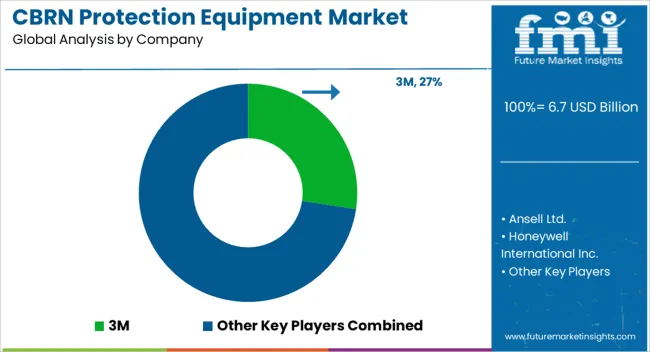
Some of the leading players operating in the CBRN protection equipment market are 3M, Ansell Ltd, Honeywell, AirBoss of America Corp, and Indra among others. Market players are currently focusing on increasing customer retention and strengthening their relationships with existing customers. Long-term relationships with customers and vendors can enable companies to acquire long-term contracts for the deployment of CBRN protection equipment.
For instance:
| Attribute | Details |
|---|---|
| Growth Rate | CAGR of 5.6% from 2025 to2035 |
| Market Value in 2025 | USD 6 billion |
| Market Value in 2035 | USD 10.3 billion |
| Base Year for Estimation | 2025 |
| Historical Data | 2020 to 2025 |
| Forecast Period | 2025 to 2035 |
| Quantitative Units | Revenue in USD Billion and CAGR from 2025 to 2035 |
| Report Coverage | Revenue Forecast, Company Ranking, Competitive Landscape, Growth Factors, Trends, and Pricing Analysis |
| Segments Covered | Product Type, Category, End Use, Region |
| Regions Covered | North America; Latin America; Western Europe; Eastern Europe; South Asia and Pacific; East Asia; Middle East & Africa |
| Key Countries Profiled | United States, Canada, Brazil, Mexico, Germany, United Kingdom, France, Spain, Italy, Poland, Russia, Czech Republic, Romania, India, Bangladesh, Australia, New Zealand, China, Japan, South Korea, GCC Countries, South Africa, Israel, Rest of MEA |
| Key Companies Profiled | 3M; Ansell Ltd.; Honeywell International Inc.; AirBoss of America Corporation; Drägerwerk AG & Co. KGaA; MSA Safety Inc; HDT Global; Avon Protection Systems; Chemviron Carbon; LION Group, Inc.; Blauer Manufacturing Co., Inc.; AMETEK, Inc.; Ouvry - Systèmes de protection NRBC; MDH Defence; Seyntex; Portsmouth Aviation Ltd.; BLÜCHER GmbH; ROFI |
The global CBRN protection equipment market is estimated to be valued at USD 6.7 billion in 2025.
The market size for the CBRN protection equipment market is projected to reach USD 11.2 billion by 2035.
The CBRN protection equipment market is expected to grow at a 5.3% CAGR between 2025 and 2035.
The key product types in CBRN protection equipment market are mobile / transportation CBRN protection equipment, _air purification units, _integrated colpro systems, _protective entrances, _rov bags, _medical transportation sets, unhardened collective protection systems (ucps), personal protective equipment (ppe), decontamination shelter systems, individual, _2 line, _3 line and _4 line.
In terms of category, c decontamination segment to command 35.0% share in the CBRN protection equipment market in 2025.






Our Research Products

The "Full Research Suite" delivers actionable market intel, deep dives on markets or technologies, so clients act faster, cut risk, and unlock growth.

The Leaderboard benchmarks and ranks top vendors, classifying them as Established Leaders, Leading Challengers, or Disruptors & Challengers.

Locates where complements amplify value and substitutes erode it, forecasting net impact by horizon

We deliver granular, decision-grade intel: market sizing, 5-year forecasts, pricing, adoption, usage, revenue, and operational KPIs—plus competitor tracking, regulation, and value chains—across 60 countries broadly.

Spot the shifts before they hit your P&L. We track inflection points, adoption curves, pricing moves, and ecosystem plays to show where demand is heading, why it is changing, and what to do next across high-growth markets and disruptive tech

Real-time reads of user behavior. We track shifting priorities, perceptions of today’s and next-gen services, and provider experience, then pace how fast tech moves from trial to adoption, blending buyer, consumer, and channel inputs with social signals (#WhySwitch, #UX).

Partner with our analyst team to build a custom report designed around your business priorities. From analysing market trends to assessing competitors or crafting bespoke datasets, we tailor insights to your needs.
Supplier Intelligence
Discovery & Profiling
Capacity & Footprint
Performance & Risk
Compliance & Governance
Commercial Readiness
Who Supplies Whom
Scorecards & Shortlists
Playbooks & Docs
Category Intelligence
Definition & Scope
Demand & Use Cases
Cost Drivers
Market Structure
Supply Chain Map
Trade & Policy
Operating Norms
Deliverables
Buyer Intelligence
Account Basics
Spend & Scope
Procurement Model
Vendor Requirements
Terms & Policies
Entry Strategy
Pain Points & Triggers
Outputs
Pricing Analysis
Benchmarks
Trends
Should-Cost
Indexation
Landed Cost
Commercial Terms
Deliverables
Brand Analysis
Positioning & Value Prop
Share & Presence
Customer Evidence
Go-to-Market
Digital & Reputation
Compliance & Trust
KPIs & Gaps
Outputs
Full Research Suite comprises of:
Market outlook & trends analysis
Interviews & case studies
Strategic recommendations
Vendor profiles & capabilities analysis
5-year forecasts
8 regions and 60+ country-level data splits
Market segment data splits
12 months of continuous data updates
DELIVERED AS:
PDF EXCEL ONLINE
Eye Protection Equipment Market Size and Share Forecast Outlook 2025 to 2035
Head Protection Equipment Market Forecast Outlook 2025 to 2035
Electrical Safety Personal Protection Equipment (PPE) Market Size and Share Forecast Outlook 2025 to 2035
CBRNE Defense Market Size and Share Forecast Outlook 2025 to 2035
Equipment Management Software Market Size and Share Forecast Outlook 2025 to 2035
Equipment cases market Size and Share Forecast Outlook 2025 to 2035
Flu Protection Kits Market Size and Share Forecast Outlook 2025 to 2035
Teleprotection Market Growth – Trends & Forecast 2025 to 2035
ESD Protection Devices Market Insights – Trends & Demand 2023-2033
Farm Equipment Market Forecast and Outlook 2025 to 2035
Fire Protection Materials Market Size and Share Forecast Outlook 2025 to 2035
Fall Protection Market Size and Share Forecast Outlook 2025 to 2035
Golf Equipment Market Size and Share Forecast Outlook 2025 to 2035
Fire Protection System Pipes Market Size and Share Forecast Outlook 2025 to 2035
DDoS Protection Market Size and Share Forecast Outlook 2025 to 2035
Port Equipment Market Size and Share Forecast Outlook 2025 to 2035
Fire Protection Systems for Industrial Cooking Market Growth - Trends & Forecast 2025 to 2035
DDoS Protection & Mitigation Security Market Growth - Trends & Forecast through 2034
Data Protection as a Service (DPaaS) Market
Surge Protection Device Market Size and Share Forecast Outlook 2025 to 2035

Thank you!
You will receive an email from our Business Development Manager. Please be sure to check your SPAM/JUNK folder too.
Chat With
MaRIA